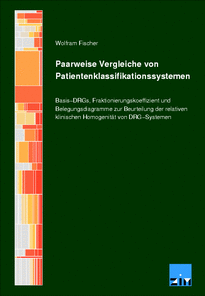| |
Abstract (English) |
1 |
| |
|
|
Introduction |
This study complements
the customary statistical homogeneity analyses
(i. e. the computations of the achievable variance reduction
and the remaining dispersion within DRGs)
by means of a comparison of DRG systems on the level of base DRGs.
|
2 |
Data |
The study is based on 900,000 records from Swiss hospitals from
the years 2000 to 2003.
The records were selected according to quality criteria.
|
3 |
Method |
Pair comparisons were conducted to try to compute the
divergence in the assignment of base DRGs of the AP-DRG,
APR-DRG, AR-DRG, IR-DRG systems among each other, and
for individual evaluations also according to SQLape, LDF
and CCS, and to represent the results graphically. For
this purpose, a so-called "fractionation coefficient"
was developed.
Visualisation was effected on the basis of treemaps.
|
4 |
Results |
The study yielded the following results: the actual DRG
systems (AP, APR, AR, IR) partially display similar grouping
concepts in the medical sphere.
In this respect, the greatest similarities exist between AP and APR,
and between IR and APR.
In the surgical sphere, AP and, to a lesser extent, AR
were found to have some common features with APR;
apart from this, it became apparent that the surgical base DRGs
are more diverse in their make-up than medical base DRGs.
The most conspicuous differences were discovered between
the surgical base IR DRGs and the surgical base DRGs
of the other DRG systems.
|
5 |
| |
In order to be able to compare the SQLape categories with the
base DRGs in spite of the differing construction approach,
the SQLape code of the main treatment was established for each
individual hospital case. In addition, some analyses were also
conducted with the help of the primary SQLape codes computed
by the manufacturer. Correspondence with the other systems
was relatively low. However, the different perspective also
can serve to detect deficiencies in the DRG systems.
|
6 |
| |
In comparison with the CCS classification, which is also
based on a diverging concept, all the systems showed great
differences,
with the surgical SQLape main treatment categories
being the exception.
|
7 |
Conclusions |
The definitions of a great number of base DRGs are
distinctly different in the systems under scrutiny.
With regard to the choice of a DRG system, this means that it
is not merely a licenser and a cooperation model that are chosen,
but at the same time also a certain way of viewing clinical treatment.
|
8 |
 Paarweise PCS-Vergleiche (Zusammenfassung)
Paarweise PCS-Vergleiche (Zusammenfassung) Coefficient de fractionnement (Résumé)
Coefficient de fractionnement (Résumé) Dispartig-koeficiento (Koncizigo)
Dispartig-koeficiento (Koncizigo) "Refined" DRGs
"Refined" DRGs